Wednesday – Bodenham Lake – Another morning that is nothing like one’s expectations of summer. Stormy clouds race across a windy sky. Drizzle falls. Along the track where Old Man’s Beard is coming into flower, now the white stars of a clematis, the fluffy beards will not appear 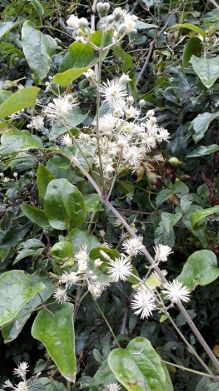 for some time yet. Blackberries are ripening as are Haws. Sloes are also ripe. Sand Martins feed low over the lake. On the meadow just a few Birds-foot Trefoil still flower; Clover, Dock and grasses are turning brown. Fungi are appearing in the copse. The lake is quiet, mainly because there is not a single Canada Goose in sight. Sixteen Mallard, a Tufted Duck and a Teal are in the scrape. Another eight Tufted Duck are out on the water with a few more Mallard. A pair of Mute Swans and cygnets are at the western end along with a single Canada Goose swimming out of the corner. The bank in front of the hide is bright with yellow Ragwort and St John’s Wort and purple Black Knapweed and, down on the edge of the water, Purple Loosestrife. A single Cormorant is in the trees. Himalayan Balsam is spreading along the far shore. A Moorhen appears on the scrape with two tiny chicks. Then a second adult with two more chicks. The adults and three chicks disappear around the reed bed leaving one squeaking chick on the scrape. An adult reappears but the chick still does not follow. Eventually the chick heads off around the reed bed too. A second Cormorant glides in and lands in an ungainly fashion in the trees. A Green Woodpecker yaffles. Clouds float through the tree tops on Dinmore Hill. Back along the meadow an Oak has a good crop of acorns. Some apples are ripe in the dessert orchard, including the Irish Peach which I had mistaken for another variety but the flavour soon corrects that misapprehension.
for some time yet. Blackberries are ripening as are Haws. Sloes are also ripe. Sand Martins feed low over the lake. On the meadow just a few Birds-foot Trefoil still flower; Clover, Dock and grasses are turning brown. Fungi are appearing in the copse. The lake is quiet, mainly because there is not a single Canada Goose in sight. Sixteen Mallard, a Tufted Duck and a Teal are in the scrape. Another eight Tufted Duck are out on the water with a few more Mallard. A pair of Mute Swans and cygnets are at the western end along with a single Canada Goose swimming out of the corner. The bank in front of the hide is bright with yellow Ragwort and St John’s Wort and purple Black Knapweed and, down on the edge of the water, Purple Loosestrife. A single Cormorant is in the trees. Himalayan Balsam is spreading along the far shore. A Moorhen appears on the scrape with two tiny chicks. Then a second adult with two more chicks. The adults and three chicks disappear around the reed bed leaving one squeaking chick on the scrape. An adult reappears but the chick still does not follow. Eventually the chick heads off around the reed bed too. A second Cormorant glides in and lands in an ungainly fashion in the trees. A Green Woodpecker yaffles. Clouds float through the tree tops on Dinmore Hill. Back along the meadow an Oak has a good crop of acorns. Some apples are ripe in the dessert orchard, including the Irish Peach which I had mistaken for another variety but the flavour soon corrects that misapprehension.
Monday – Talgarth-Llangors – The sky is full of different clouds, white and grey, towering and feathery. From the car park in Talgarth, l head towards the town centre then along Heol Las (Green Road) and then southwards on a narrow lane, Bell Street, once called New Road. Linnets twitter on wires. The lane is closed by a locked gate but walkers and cyclists can use it. Hazel nut shells crunch underfoot. To the east is a deep valley with a tributary to the Afon Ennig rushing through. The sun has emerged above the thick clouds that lay over the Black Mountains. A seat remembers John Gardiner who died aged only 53. On down the track. A hill-fort lays across the valley but is hidden from view by the trees. Onto a footpath which should cross the Abergavenny road but disappears on the far side, so down the wide verge a short distance and off along a lane. A small lane leads off at Penyrwrlodd. It is very humid! Through a gate and then over a stile beside a deep sunken greenway. Along the edge of a sheep pasture beside a thin strip of woodland. Over another stile. Mynydd Troed lays ahead, a hill topping out at 609 metres. Across another pasture. To the west are the Brecon Beacons, Pen-y-fan and Corn Ddu. Into another meadow where over a fence is long barrow.
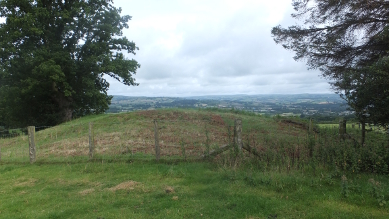
Penyrwrlodd long barrow was discovered in 1972 when a farmer removing stones from a mound in his field found some larger stone slabs which lined a hole leading deeper into the mound. Within this chamber were piles of human bone. He contacted Hubert Savory, an archaeologist at the National Museum and an expert in prehistoric burial mounds, and Savory came to see the new find as soon as he could. This discovery must have come as a considerable surprise to him as archaeologists had been mapping burial mounds in this part of Wales for generations. Yet here was the largest and best preserved example in Powys, completely unknown! An excavation revealed that the mound was a type of tomb in use from around 3,600 BCE, consisting of a rectangular stone mound which widened at its south-east end. Here the walls of the mound bowed inwards to create a forecourt. Piercing the sides of the mound were several stone-lined chambers which contained the remains of at least six people including a very rare complete skull of a man who had died in his mid-20s. The strontium isotope results suggest that the majority of individuals here did not source their childhood diet locally. One individual in this group, dated to the first few centuries of the 4th millennium BCE, appears to come from outside the British Isles, providing evidence for migration during the transition to farming in Wales.
An Oak tree grows at the northern end. Underneath is a good number of boletus. Back across the stile and on southwards. There are Puffballs in this pasture. Across the fields to Neuadd Fach where the route follows a sunken lane. The bedrock is exposed, St Maughan’s Formation Sandstone from the Devonian. The track reaches Nant yr Eiddil, a stream. Crossing it is easier than I had expected. Most flowers have finished blooming now. Tall stalks of Hedge Woundwort stand green and flowerless. A Warbler wheeps. The track emerges at Glan yr Afon. I decide to head back north-eastwards and then south again along the lanes. Past Upper Trewalkin which has a fine stone farmhouse. A field has a locally made gate, welded angle-iron and strips of iron with a forged handle, not pretty but solidly functional. More gates are similar but all made with slightly different pieces of iron. Past Penyrheol. The lane divides and my route runs around the north edge of the foot of Mynydd Troed. A detour up an extremely slippery, muddy path to the motte of Carn-y-Castell. It is a shallow, ploughed down mound which I would have missed is it was not marked on the map. It is possibly the “Castellum Waynardi” or “Waynard’s Castle” of the mid 12th century. It is suggested it is named after Walkelin Visdelon whose father, Humphrey, accompanied Bernard de Neufmarché in his conquest of Brycheiniog and who appears to have been granted the manor. Looking westwards, my destination, Llangors and Llangors Lake lay under the Brecon Beacons. The hillside here still has flowering Spear Thistles, Mouse Ear Hawkweed, Lady’s Mantle, Yarrow and Harebells. Back down the path which is even more treacherous going down, reaching the bottom feeling both pleased and surprised I have done so without mishap. The roadside trees are an interesting collection of Ash, Rowan, Crab Apple, Field Maple, Beech, Willow and Hazel.
Off the lane onto another which drops steeply past Upper, Middle and Lower Penllanafel farms. The first farm has a 16th or 17th century farmhouse and the others are of a similar or slightly later age. A ginger cat trots along the lane. The next farm is Upper Cefnwern. House Sparrows chirp. Swallows call overhead. I saw my last Swift two days ago. A Chiffchaff squeaks as it feeds along the hedgerow. There is much chomping behind the hedge, clearly a herd of cows hidden from view but not the ears. Numerous House Martins have joined the Swallows over the fields. Chaffinches rise from the road. Old Oaks stand outside Lower Cefnwern farm. The barns have all been converted. The road is still descending. Wrens tick in the hedge. A very large flock of corvids are circling woods some distance away in the valley. The lane crosses a stream, which goes on to join the Nant Cwy. A Red Admiral flies past. Vermilion berries of Wild Arum shine from under the hedgerow.
The lane enters Llangors. Past Plas Farm which appears on Tithe Map of 1840 in present form. Farmyard was then U shaped and opposite range side was thus apparently altered in the later 19th century to provide additional access to the north-east. The range backing onto lane damaged by fire last century. A little green with a tree ringed with a seat is opposite. A large house stands opposite facing down the road towards the village. The road contains some older properties, probably 18th century with 19th and 20th century infilling. A chapel has a plaque – Bethel, Addoldy Y Trefnyddion Calfinaidd Adeiladwwyd 1852, meaning Bethel, Place of Worship of the Calvinists, Constructed 1859. The Castle Inn is a large pub. Next to it is the old school. Just down the road is a Baptist Chapel, Penuel, 1829. Another large pub is the Red Lion.
There is a record of a church in Llangors from 1152. There is a possibility that a Celtic monastery existed here from the 7th century to the Norman period, but its location is unknown. It seems to have been dedicated to St Mary and St Paulinus until the Reformation, but since then only the second dedication has remained. St Paulinus, Paul Aurelian was a 6th century Celtic saint. He was the son of a Welsh nobleman, educated by St Illtyd at 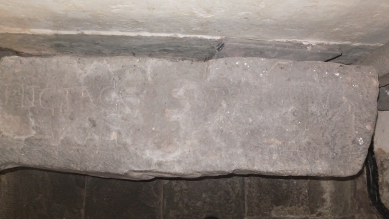 Llantwit Major, after which he founded a monastic settlement at Llanddeusant and was ordained priest. Paulinus is thought to have left Llangorse for the court of King Mark of Cornwall, sailing from there to Brittany where he became the first Bishop of Leon. Rhygyfarch records the young St David spent many years as a pupil of Paulinus, and once restored the sight of his ageing tutor. St Teilo was also a pupil of Paulinus, who was buried in a shrine at the former cathedral of St Pol de Leon, Brittany. A Llandaff Charter of around the 8th century records of a grant by King Awst of Brycheiniog and his sons to Bishop Euddogwy of a royal estate corresponding to the present parish of Llangorse. The Awst Charter records the donation by Awst of his own and his sons bodies to the church for burial, indicating that Llangorse church could have been a royal burial ground. Another Llandaff Charter describes a meeting in a monastery at Llangorse in 925 between King Tewdewr of Brycheiniog and Bishop Libiau. The current church dates almost entirely to the 15th and 16th centuries, with a major rebuilding in 1874 by T Nicholson, at a cost of £1033, when the sanctuary was added. The roof of the south aisle is a very good example of late 15th century barrel-vaulting, or “wagon-roof” construction. A simple octagonal font is 13th century. A fine organ of 1764 by John Byfield from St John’s, Cardiff was installed in 1894. There is a complete ring of 6 bells from the Evans foundry and a frame of 1721. Inside the church is a grave slab from the 6th or 7th century inscribed in Latin. The floor behind the pulpit is covered with newspaper which in turn is covered in bat droppings.
Llantwit Major, after which he founded a monastic settlement at Llanddeusant and was ordained priest. Paulinus is thought to have left Llangorse for the court of King Mark of Cornwall, sailing from there to Brittany where he became the first Bishop of Leon. Rhygyfarch records the young St David spent many years as a pupil of Paulinus, and once restored the sight of his ageing tutor. St Teilo was also a pupil of Paulinus, who was buried in a shrine at the former cathedral of St Pol de Leon, Brittany. A Llandaff Charter of around the 8th century records of a grant by King Awst of Brycheiniog and his sons to Bishop Euddogwy of a royal estate corresponding to the present parish of Llangorse. The Awst Charter records the donation by Awst of his own and his sons bodies to the church for burial, indicating that Llangorse church could have been a royal burial ground. Another Llandaff Charter describes a meeting in a monastery at Llangorse in 925 between King Tewdewr of Brycheiniog and Bishop Libiau. The current church dates almost entirely to the 15th and 16th centuries, with a major rebuilding in 1874 by T Nicholson, at a cost of £1033, when the sanctuary was added. The roof of the south aisle is a very good example of late 15th century barrel-vaulting, or “wagon-roof” construction. A simple octagonal font is 13th century. A fine organ of 1764 by John Byfield from St John’s, Cardiff was installed in 1894. There is a complete ring of 6 bells from the Evans foundry and a frame of 1721. Inside the church is a grave slab from the 6th or 7th century inscribed in Latin. The floor behind the pulpit is covered with newspaper which in turn is covered in bat droppings.
Over the stream, Nant Cwy. Past the closed Village Stores. A new primary school is under construction. Across Llangors Common to the lake, Llyn Syfaddan in Welsh. It is the largest natural body of water in the whole of South Wales. Giraldus Cambrensis wrote about the lake in his book about journeying through Wales in the late 12th century, reporting the local 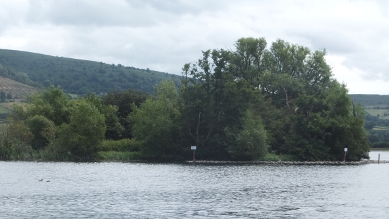 tradition that the birds in the area only ever sang for a truly Welsh prince or ruler. He also said the lake was often called Clamosus, Latin for “noisy”, which may have referred to the birds or the noise ice makes when it cracks. He also recorded how miraculous it was with numerous strange colours that the lake water takes on at certain times. And the lake has long been associated with fairies, very large eels, and a witch who lived beside the lake and was known to frighten-away naughty children! The whole valley was created in the Devensian, some two million years ago by glaciation. The lake is the setting for a number of myths and legends – including one that says the lake is the location for the submerged Roman city of Loventium. In early medieval history it was known as “Brecenenmere”. A reconstruction of a crannog is not on the original site. The crannog is an artificial island, measuring about 40 metres in width and is situated 30 or 40 metres off the northern shore of the lake. It dates from the
tradition that the birds in the area only ever sang for a truly Welsh prince or ruler. He also said the lake was often called Clamosus, Latin for “noisy”, which may have referred to the birds or the noise ice makes when it cracks. He also recorded how miraculous it was with numerous strange colours that the lake water takes on at certain times. And the lake has long been associated with fairies, very large eels, and a witch who lived beside the lake and was known to frighten-away naughty children! The whole valley was created in the Devensian, some two million years ago by glaciation. The lake is the setting for a number of myths and legends – including one that says the lake is the location for the submerged Roman city of Loventium. In early medieval history it was known as “Brecenenmere”. A reconstruction of a crannog is not on the original site. The crannog is an artificial island, measuring about 40 metres in width and is situated 30 or 40 metres off the northern shore of the lake. It dates from the  end of the 9th century and was one of several royal houses belonging to the rulers of Brycheiniog. It is the only crannog in Wales and was constructed of brushwood and sandstone boulders, reinforced and surrounded by several lines of oak plank palisade. Tree-ring dating of the well-preserved timbers has established that they were felled between 889 and 893. The site seems to have been influenced by Irish building techniques, and was possibly constructed with the assistance of an Irish master craftsman. Its ending is unclear. Relations between Alfred the Great’s English territories and Brycheiniog deteriorated in the wake of Alfred’s death and in 916 Aethelflaed, the daughter of Alfred, sent an army into the Welsh kingdom. A number of burnt timbers have been found in the crannog and it is possible that the island was attacked and its defenders put to the sword by the English army. In 1925 a 25 foot-long wooden dug-out canoe was excavated from the mud near the northern shore of the lake, and in 1990 a second dug-out boat was excavated from close by. These have been dated from between the 8th and 11th centuries.
end of the 9th century and was one of several royal houses belonging to the rulers of Brycheiniog. It is the only crannog in Wales and was constructed of brushwood and sandstone boulders, reinforced and surrounded by several lines of oak plank palisade. Tree-ring dating of the well-preserved timbers has established that they were felled between 889 and 893. The site seems to have been influenced by Irish building techniques, and was possibly constructed with the assistance of an Irish master craftsman. Its ending is unclear. Relations between Alfred the Great’s English territories and Brycheiniog deteriorated in the wake of Alfred’s death and in 916 Aethelflaed, the daughter of Alfred, sent an army into the Welsh kingdom. A number of burnt timbers have been found in the crannog and it is possible that the island was attacked and its defenders put to the sword by the English army. In 1925 a 25 foot-long wooden dug-out canoe was excavated from the mud near the northern shore of the lake, and in 1990 a second dug-out boat was excavated from close by. These have been dated from between the 8th and 11th centuries.
Ranulph Higden (1299-1363), the monk of Chester, summed up in Latin the fame of the lake, and John Trevisa (1387) translated the passage into English:–
|
Ad Brecknoc est vivarium Satis abundans piscium Saepe coloris varii Coman gerens pommarii Structuras aedificii Saepe videbis inibi Sub lacu cum sit gelidus Mirus auditur sonitus Si terrae princeps venerit Aves cantare jusserit Statim compromunt nodulos Nil concinunt nil caeterus. |
There is a pole in Breighnok There ynne of fische is many a flok Oft he changeth his hewe on cop And beareth aboue a gardyn crop Ofte tyme how it be Schap of hous there thou schalt see When the pole is frore hit is wonder Of the noise that there is under Gif the prince of the londe hote Briddes singeth with merry note As mery as they kan And singeth for noon other man |
Possibly not the best time of year to visit, there are several camping and caravan sites around it and boat and canoe hire so it is noisy and busy. The majority of the wildfowl are by the launching hard being fed by visitors.
Off back towards Talgarth. A Red Kite flies over the edge of the village. I take the main road back towards Talgarth. Large, solid house stand by the roadside, Llangors Villa. Next to it is an archway with Cross in the stone has what looks like a church or chapel behind it with a large Victorian Gothic house nearby. Until 1840s this was a village farmhouse but was bought by London barrister Abraham Kirkman, described on his monument in Llangors church as “a profound antiquary”, who rebuilt the house and barn in Gothic Revival style, very likely in connection with the nearby development of Treberfydd under Robert Raikes with J L Pearson as architect, also with the redevelopment of Goodrich under Lord Merrick with whom Kirkman had connections. The Kirkman family were harpsichord makers of Franco-German origin; Abraham Kirkman died in 1870 and is buried in the family vault in London. Some of the barns of Lower Pendre Farm have been converted. On past Upper Pendre Farm where the raised platform for the milk churns still stands. Out into the countryside. A few flowers brighten the roadside, Meadow Cranesbills, Honeysuckle, Woody Nightshade, Great Willowherb, Good King Henry and the last few Meadowsweet. A line of trees in the valley to the west marks the route of the disused railway, the Mid-Wales Railway closed in December 1962. Two more Red Kites fly over. The are several new builds out at least major extensions being carried out. A Great Spotted Woodpecker is bashing away at a dying tree. Another appears and there is a brief flurry. A furry caterpillar is in the road, so I move it to the verge. A field of oats is golden and ready for harvest. Another golden field is wheat.
Into the village of Trefecca. Modern housing is on the outskirts. A farm’s barn is a self catering cottage. The big corrugated iron barn behind it is by Mifflin of Leominster. A terrace in pale limestone stands opposite the gardens of Trefecca College, the home of Howell Harris, 1714-73, who formed the first Methodist society here. The original farmhouse was enlarged and aggrandised, 1752-9, in a modern Gothick style. From 1842-1906 the site served as a Calvinistic Methodist Training College and it is currently a Presbyterian lay training establishment.  A motte and bailey are marked on the map but they seem to have disappeared under a large bungalow and outbuildings. Most of the motte was destroyed when the railway was cut through. This may have been Waynard’s Castle although the motte referred to above seems to be the preferred option. It was a timber castle. The clouds are darkening and the wind is rising.
A motte and bailey are marked on the map but they seem to have disappeared under a large bungalow and outbuildings. Most of the motte was destroyed when the railway was cut through. This may have been Waynard’s Castle although the motte referred to above seems to be the preferred option. It was a timber castle. The clouds are darkening and the wind is rising.
Out of the village. A large ancient Oak stands in a field. It starts to rain. College Farmhouse was built originally in 1576, and leased to the Countess of Huntingdon in 1764 to establish a training college for dissenting protestantism, the college opening in 1768, at the inauguration of which George Whitefield preached. Closed down when lease expired in 1791/8, and the college moved to Cheshunt, the building then reverting to a farmhouse. Whitefield broke away to found the Calvanistic Methodists in or before 1741, although the Countess remained faithful to the original austere approach. The building is in the Gothic style, The Countess was a niece of Lady Fanny Shirley of Twickenham, a friend of Horace Walpole, and would seemingly be acquainted with the more archaeologically correct form of the Gothic style promoted by him through William Robinson at Strawberry Hill. The road continues into Talgarth. Route
Wednesday – Stoke-on-Trent – We visit the city famous as “The Potteries”. It is a federation of six towns which combined in the early 20th century. It took its name from Stoke-upon-Trent, where the town hall and the railway station are located, along with Hanley, the primary commercial centre, Burslem, Tunstall, Longton and Fenton. The city is the home of the pottery industry in England. Formerly a primarily industrial conurbation, it is now a centre for service industries and distribution centres.
We first visit the Moorcroft Heritage Centre . William Moorcroft, a graduate of what is now the Royal College of Art in London started producing fine art pottery in 1897. He sold through stores such as Liberty of London, Harrods and Tiffany & Co. in New York. In 1913, with the aid of funding from Liberty, William moved production of his art pottery to the present factory in Sandbach Road under the name of W. Moorcroft Ltd. Walter Moorcroft assumed the responsibilities of sole Moorcroft designer in 1945. In 1986 Sally Tuffin took over design. Aided by Phillip Richardson, she introduced animals, birds and geometric patterns into the vision of Moorcroft art. Moorcroft 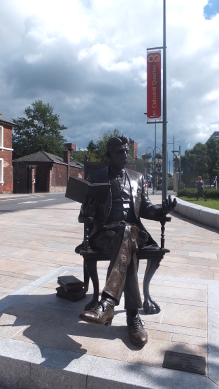 is known mainly for its tube lining designs where patterns are delineated by raised lines and coloured within. The centre is around a bottle kiln and contains a museum of many iconic pieces of Moorcroft.
is known mainly for its tube lining designs where patterns are delineated by raised lines and coloured within. The centre is around a bottle kiln and contains a museum of many iconic pieces of Moorcroft.
We then parked at our hotel and headed into the city centre. Large roads tend to compartmentalise the city. There are many large Victorian commercial buildings reflecting the wealth of the potteries in that period. Many more modern buildings, some actually of architectural merit, are among the older edifices. Much of the industrial heritage has been bulldozed. The Potteries Museum and art Gallery is one of the better modern buildings. Outside is a statue of Arnold Bennett, a local man. The second floor of the museum is given to the history of the potteries. Since  the 17th century, the area has been known for its industrial-scale pottery manufacturing. Companies such as Royal Doulton, Dudson Ltd, Spode (founded by Josiah Spode), Wedgwood (founded by Josiah Wedgwood), Minton (founded by Thomas Minton) and Baker & Co. (founded by William Baker) were established and based there. Stoke-on-Trent lies at the point of erosion where the coal seams of the Pennine Coal Beds have been preserved but are close enough to the surface to be easily mined. There also happens to be coarse and fine clays and ironstone. The construction of the Trent and Mersey Canal (completed in 1777) enabled the import of china clay from Cornwall together with other materials and facilitated the production of creamware and bone china. On the first floor is a display of Saxon finds including part of the fabulous Staffordshire Hoard, discovered in a field near the village of Hammerwich, near Lichfield, on 5th July 2009, it consists of more than 3,500 items, that are nearly all martial or warlike in character. The Staffordshire Hoard totals 5.094 kilos of gold, 1.442 kilos of silver and 3,500 cloisonné garnets. Also in an adjoining gallery is a Spitfire, commemorating the fact that its designer, Reginald Mitchell, was born in Stoke. Opposite the museum is Albion Street where there is the Bethesda New Connexion Methodist Chapel, one of the largest non-conformist chapels outside
the 17th century, the area has been known for its industrial-scale pottery manufacturing. Companies such as Royal Doulton, Dudson Ltd, Spode (founded by Josiah Spode), Wedgwood (founded by Josiah Wedgwood), Minton (founded by Thomas Minton) and Baker & Co. (founded by William Baker) were established and based there. Stoke-on-Trent lies at the point of erosion where the coal seams of the Pennine Coal Beds have been preserved but are close enough to the surface to be easily mined. There also happens to be coarse and fine clays and ironstone. The construction of the Trent and Mersey Canal (completed in 1777) enabled the import of china clay from Cornwall together with other materials and facilitated the production of creamware and bone china. On the first floor is a display of Saxon finds including part of the fabulous Staffordshire Hoard, discovered in a field near the village of Hammerwich, near Lichfield, on 5th July 2009, it consists of more than 3,500 items, that are nearly all martial or warlike in character. The Staffordshire Hoard totals 5.094 kilos of gold, 1.442 kilos of silver and 3,500 cloisonné garnets. Also in an adjoining gallery is a Spitfire, commemorating the fact that its designer, Reginald Mitchell, was born in Stoke. Opposite the museum is Albion Street where there is the Bethesda New Connexion Methodist Chapel, one of the largest non-conformist chapels outside 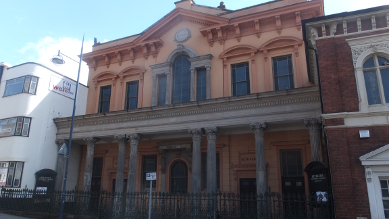 London. It was built in 1819 with additions of 1859 and 1887 in brick with stuccoed façade. Rear of the chapel, which can be seen from the museum forecourt, is in Flemish bond brickwork with buff headers. Abutting the front of the chapel is a fine Art Deco building.
London. It was built in 1819 with additions of 1859 and 1887 in brick with stuccoed façade. Rear of the chapel, which can be seen from the museum forecourt, is in Flemish bond brickwork with buff headers. Abutting the front of the chapel is a fine Art Deco building.
In the early evening we venture out for a pint. This proves a little difficult as two of the recommended pubs are shut despite contrary information on the net. We manage to find The Reardon which has a fine selection of ales. It also has a room with three snooker tables, none of which is in use, which seems odd. We then head south past St Mark’s church, designed by J. Oates, erected in 1833 of freestone ashlars in the Early English style at a cost of £10,000. We have dinner at Mirchi, probably one of the best Indian restaurants we have found outside Bradford or Birmingham. The salted lassi certainly was the best ever!
We return to the hotel. Opposite is the Telephone Building, now a bar. It was built around 1900 in red brick and terracotta with a plain tiled roof in the Eclectic style, with main block of three storeys, and three narrow bays with flanking towers, with all vertical spaces elongated.
Friday – Long Mynd-Leebotwood – The Manchester train is running twenty minutes late. The notice board states it is due to animals on the track, Arriva being keen to point out that for once it is not their fault! In Church Stretton the bright sunny morning has gone to be replaced by a 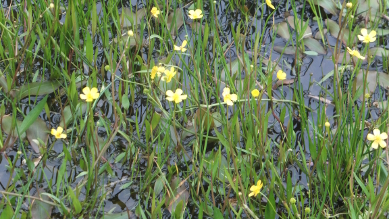 cool wind and thickening cloud. Through Church Stretton to the Cardingmill Valley. Nuthatches call from trees in the gardens of houses at the for of the valley. Up past the National Trust buildings, the former mill and the Aerated Water Works, the first bottled water enterprise in the area. Blackbirds call alarms. Several Robins are in song. A mewing Common Buzzard circles high over the hills. The stream bubbles down the valley although the water level is low. Up Motts road, a rocky path. Purple Heather and green Bracken cover the hills. A Common Buzzard hovers on the wind above the hill. Young Stonechats fly across the Bracken in various stages of plumage development. Black faeces are deposited on a mound probably by a Fox. Meadow Pipits sit on the green fronds, watching and squeaking.
cool wind and thickening cloud. Through Church Stretton to the Cardingmill Valley. Nuthatches call from trees in the gardens of houses at the for of the valley. Up past the National Trust buildings, the former mill and the Aerated Water Works, the first bottled water enterprise in the area. Blackbirds call alarms. Several Robins are in song. A mewing Common Buzzard circles high over the hills. The stream bubbles down the valley although the water level is low. Up Motts road, a rocky path. Purple Heather and green Bracken cover the hills. A Common Buzzard hovers on the wind above the hill. Young Stonechats fly across the Bracken in various stages of plumage development. Black faeces are deposited on a mound probably by a Fox. Meadow Pipits sit on the green fronds, watching and squeaking.
Across the top of Long Mynd. Several ponies graze amongst the sheep. On to the Port Way. The surrounding hills and the Shropshire Plain are misty, although the outcrops of Stiperstones are clear enough. The Port Way continues on a metalled lane. Past a pool of yellow flowers, Lesser Spearwort. A cronking Raven flies over. Swallows chatter as they fly low over the Heather. A flock of  Starlings feeds in a pasture. As the lane starts to descend the Shropshire Plain is ahead with the great whale back of The Wrekin rising out of it end of the chain of volcanic rocks of the Uriconian series, of Precambrian, running north-east from Ragleth Hill. Harebells beside the road are a particularly rich blue. Past High Park House of 1868 and another house, possibly Queensbounty according to the 1883 map, where House Sparrows fly up into the bushes chattering incessantly. Honeysuckle is in flower although some have already turned to crimson berries. Yellow and orange Toadflax flowers in the hedge. Toadflax has many colloquial names, often containing the word “butter” and “eggs” reflecting its yellow and orange colouration. Just the tips of Rosebay Willowherb have flowers, lower down are the seed pods, the bottom ones already split to reveal their fluffy seeds. Black Knapweed is also in flower, yellow Smooth Sow Thistle almost finished.
Starlings feeds in a pasture. As the lane starts to descend the Shropshire Plain is ahead with the great whale back of The Wrekin rising out of it end of the chain of volcanic rocks of the Uriconian series, of Precambrian, running north-east from Ragleth Hill. Harebells beside the road are a particularly rich blue. Past High Park House of 1868 and another house, possibly Queensbounty according to the 1883 map, where House Sparrows fly up into the bushes chattering incessantly. Honeysuckle is in flower although some have already turned to crimson berries. Yellow and orange Toadflax flowers in the hedge. Toadflax has many colloquial names, often containing the word “butter” and “eggs” reflecting its yellow and orange colouration. Just the tips of Rosebay Willowherb have flowers, lower down are the seed pods, the bottom ones already split to reveal their fluffy seeds. Black Knapweed is also in flower, yellow Smooth Sow Thistle almost finished.
The village of Woolstaston is heralded by a large flock of House Sparrows. The church hall remains a wreck. On through to the outskirts of Leebotwood which lays on the A49. The name comes from the forest, called Botwde in the Domesday Book and Bottewode in 1170. Henry II granted this area to Augustinian canons of Haughmond Abbey with a chapel at Lega, hence the placename of Lega in Bottewode. The grant included a pasture that had belonged to Bletherus the hermit, who, it has been suggested, founded the church here.
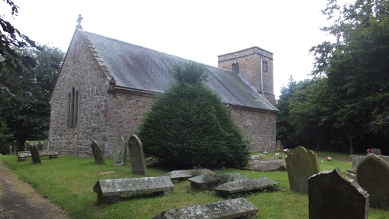
St Mary’s church lays to the west of the village. A church on the site was first recorded in 1183. The present building dates from the 13th century with the tower and other alterations of 1829. The box pews are from 1776, a hexagonal wooden pulpit is early 18th century. Beside it is a reader’s desk and clerk’s pew probably also of 1776. The circular stone font dates from 1843. An ashlar reredos is late 19th century. The east window of 1854 is probably by David Evans of Shrewsbury. A medieval wall painting of the Nativity was discovered in 1976 on the north wall of nave. There are numerous monuments of the Corbett family of Longnor Hall, which lies to the north-east. Particularly notable is large tablet monument to Sir Uvedale Corbett (d.1701) with a gadrooned base, flanking columns, and a swan-necked pediment with two 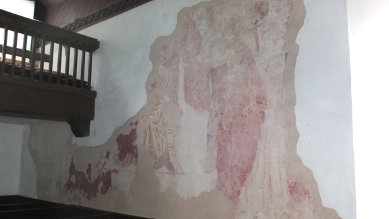 reclining figures. Another Uvedale Corbett (his father was also Uvedale) has a plaque recording that as one of “His Majesty’s Inspectors of Poor Law he was selected to organize a system of relief, first in the manufacturing districts of Lancashire and Yorkshire at the time of the Cotton Famine in 1863 and subsequently in London at a time of unprecedented distress in the Metropolitan Unions. He was afterwards appointed Chairman of two Royal Commissions to formulate schemes for Local Government and Taxation in the Isle of Man (1878) and in Ireland (1880)”. Many other Corbetts served as Members of Parliament. In the churchyard are rows of closely packed tombs of the Corbetts.
reclining figures. Another Uvedale Corbett (his father was also Uvedale) has a plaque recording that as one of “His Majesty’s Inspectors of Poor Law he was selected to organize a system of relief, first in the manufacturing districts of Lancashire and Yorkshire at the time of the Cotton Famine in 1863 and subsequently in London at a time of unprecedented distress in the Metropolitan Unions. He was afterwards appointed Chairman of two Royal Commissions to formulate schemes for Local Government and Taxation in the Isle of Man (1878) and in Ireland (1880)”. Many other Corbetts served as Members of Parliament. In the churchyard are rows of closely packed tombs of the Corbetts.
It is now raining. From the church I return a short distance back up the lane then turn south. The lane rises and falls, twists and turns. Down to a little bridge over a stream. The lane passes a number of farms and the Malthouse. The rain ceases. On down the lane with Caer Caradoc looming up ahead. Through Highfield and past Dudgeley Farm. The lane joins the road from the A49 at Quakingbrook Bridge. The brook appears to have been called the Cound Brook. Into All Stretton and a couple of pints in The Yew Tree Inn. Much has been made on-line about the foul mouthed and rude landlord, and it all appears to be accurate. On into Church Stretton for the train home. Route
Sunday – Leominster – The water level of the River Lugg is very low again. A Carrion Crow is calling excitedly in the riverside trees. Moments later a Common Buzzard flies out and crosses to one of the tall Black Poplars. The early morning mist has been dispelled by the sun. The market is a bit larger than of late but some regulars are missing – on holiday one assumes. Back round beside the Kenwater, which is also gin-clear and shallow.
Home – The last two rows of potatoes are dug. The cabbage patch is cleaned up, one of the small Willowherbs is about to seed. The cabbages have suffered slug damage; I did not look after them enough! The tree I had misidentified as a Shropshire Prune appears not to be a damson at all, the fruit is very sweet. There are also plums on the Marjorie Pippin but they quickly get fungal damage. Courgettes are still growing fast and large. A good number of peppers are picked from the greenhouse. Tomatoes are ripening well now.
Monday – Leominster – Rain falls steadily from an iron grey sky. Up the slope to the old A44 bridge, now just for pedestrians. A Blackthorn has plenty of sloes. Hawthorns and hips are turning red. Ivy is coming into flower. Pink Common Mallow lies prostate. Teasels have turned brown but are still soft to the touch. Over the A49. Spikes of Weld or Dyer’s Rocket grows out of the decaying tarmac. Acorns are developing on a small Oak. Elderberries are ripe. The old route joins the present A44 just before Eaton Bridge. The River Lugg flows shallow and sluggishly with weed and rubbish built up in places. A young Grey Wagtail flies off. Up Widgeon Meadow. The newly planted trees are ten feet tall or more now. Up the old drovers’ steps to Eaton Hill. The field has been left to grass this year. The footpath which should run along the fence has been a problem for years, getting overgrown and no-one maintaining it, but now it is buried under a wide thicket of Stinging Nettles and Burdock. The latter is spreading out into the field and the farmer would 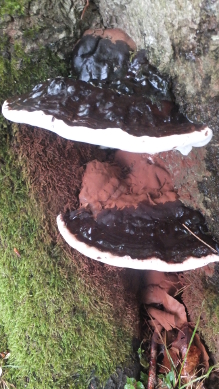 do well to deal with it sooner rather than later. The path runs through a wood above the old butts and beside the solar farm. Down the track. Blackbirds and Song Thrushes search the track edge for food. An aircraft flies over, hidden in the cloud, but my app claims it to be an RAF Airbus from Brize Norton. Back down on the river plain, fields of cereal have been harvested leaving great rounds bales of straw behind. Common Buzzards are calling. A fungus is on the base of a Beech tree. It is gleaming black-mahogany on top with a pure white lip and is probably Laquered Bracket, one of the Ganoderma family. This family contains the fungi highly prized as alternative medicines called in Chinese: língzhī; Japanese: reishi and in Vietnamese: linh chi, literally: (soul/spirit mushroom).
do well to deal with it sooner rather than later. The path runs through a wood above the old butts and beside the solar farm. Down the track. Blackbirds and Song Thrushes search the track edge for food. An aircraft flies over, hidden in the cloud, but my app claims it to be an RAF Airbus from Brize Norton. Back down on the river plain, fields of cereal have been harvested leaving great rounds bales of straw behind. Common Buzzards are calling. A fungus is on the base of a Beech tree. It is gleaming black-mahogany on top with a pure white lip and is probably Laquered Bracket, one of the Ganoderma family. This family contains the fungi highly prized as alternative medicines called in Chinese: língzhī; Japanese: reishi and in Vietnamese: linh chi, literally: (soul/spirit mushroom).
Down to the A49 again and across Brightwells’ yard to Ridgemoor Bridge. Numerous Common Pond Skaters, Gerris lacustris, are scurrying across the Lugg. Over the railway and off along a Footpath that runs beside Dale’s yard on The Marsh. The path meets the straightened section of the Lugg. The alarm on the crossing sounds and shortly after the Manchester train passes, accelerating out from the station. Dale’s Community Orchard looks neglected and abandoned. Onto the path that the route the old Leominster-Kington railway line. More Pond Skaters are beside an inspection platform on the river. A Great Spotted Woodpecker flies onto a dead tree with a chip. The Carmarthen train comes down the track, late as usual. The rain has stopped. A Common Buzzard flies out of a large stand of Willows, Sycamores and conifers and of across the river and fields. Himalayan Balsam is spreading asking the riverbank. The path reaches the Ludlow road, North Road. Over the Lugg Bridge. Several Hereford cattle are chomping on a mound of hay. Off along Eyton Lane to Crowards Mill. An orange crane fly flits from leaf to leaf. Off down the track to Summersgalls Farm. A mixed flock of Blue Tits, Long-tailed Tits, Goldcrests and Siskin are in the trees. Back along the route of the abandoned railway. A pair of Swifts feed over the Lugg, possibly the last not to have headed south. Further along House Martins dash to and fro. A patch of Meadow Puffballs, Vascellum pratense, are nearing ripeness when they will decay with clouds of spore.
Wednesday – Bodenham Lake – The sun shines although there is plenty of cloud building from the west. A Wren darts off into the bushes and sings a brief burst of song. A copper-coloured dragonfly disappears before I can get anywhere near it. Bees are disappearing right inside the flowers of Himalayan Balsam. An umbellifer flowers by the hedge. Each flower has a tiny white balls on stalks like a crown. A Chiffchaff flies off into the dense foliage of the  hedgerow. Leaves are beginning to look tired and some are yellowing. The boating bay is deserted apart
hedgerow. Leaves are beginning to look tired and some are yellowing. The boating bay is deserted apart 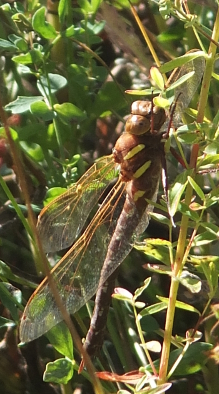 from a couple of Mallard and a Coot on the eastern edge. The meadow has been mown. The water level on the lake is low and the scrape is extensive. A few Canada Geese are resting. One emerges from the water hopping on one leg, the other seems to be injured. All the duck are in eclipse still which makes identification that bit more difficult. I think there are a pair of Gadwall present and a female Mandarin Duck. A Cormorant is drying its wings. A Common Sandpiper searches the edge of the scrape. A Moorhen is being followed by two chicks. Another appears, also with two chicks. A noisy skein of Canada Geese fly in. A pair of Mute Swans have five cygnets. There are good numbers of Mallard and Tufted Duck all around the lake. In front of the hide most is now brown, the Black Knapweed and St John’s Wort are all finished and in seed. A dragonfly lands on a stem and remains there, motionless. It is a Common Hawker, Aeshna juncea, also known as a Moorland Hawker or Sedge Darner. A raptor is screeching somewhere across the far side of the lake. A Carrion Crow lands on the scrape but is chased off by a Moorhen. A single Teal appears. Back to the orchards. Five Common Buzzards fly out of Westfield Wood.
from a couple of Mallard and a Coot on the eastern edge. The meadow has been mown. The water level on the lake is low and the scrape is extensive. A few Canada Geese are resting. One emerges from the water hopping on one leg, the other seems to be injured. All the duck are in eclipse still which makes identification that bit more difficult. I think there are a pair of Gadwall present and a female Mandarin Duck. A Cormorant is drying its wings. A Common Sandpiper searches the edge of the scrape. A Moorhen is being followed by two chicks. Another appears, also with two chicks. A noisy skein of Canada Geese fly in. A pair of Mute Swans have five cygnets. There are good numbers of Mallard and Tufted Duck all around the lake. In front of the hide most is now brown, the Black Knapweed and St John’s Wort are all finished and in seed. A dragonfly lands on a stem and remains there, motionless. It is a Common Hawker, Aeshna juncea, also known as a Moorland Hawker or Sedge Darner. A raptor is screeching somewhere across the far side of the lake. A Carrion Crow lands on the scrape but is chased off by a Moorhen. A single Teal appears. Back to the orchards. Five Common Buzzards fly out of Westfield Wood.
Friday – Talgarth-Pengenffordd – The weather forecast predicted sunshine this morning with the risk is showers later but already thickening cloud is building. Out of the car park and along the High Street to Heol Las. A footpath running beside Afon Ennig leads to the lane to Pwll-y-Wrach, Hospital Road. Over the river by a fairly new bridge. Then into Heol Penbont. The houses are a mixture of 17th century to modern. Upper Aberenig House is mid 19th century with probable earlier origins. Fir Tree Cottage has an interesting change of angle, the side of the house is parallel to the road with a more recent frontage facing the bend behind. However the rear of the building has the same alignment as the front. The lane recrosses the Afon Ennig. The lane rises through high banks. A recently built stepped water channel runs down from a field some twenty feet above the lane. Views of the hill-fort mentioned last time I was in the area are impossible. On along the lane. There is a thin strip of Bishop’s Frome Limestone, a silicate conglomerate from the Devonian and Silurian, 359-444 million years old, overlaid by Devensian till some 2 million years old. The surrounding area is Devonian St Maughans Formation sandstone, 398-416 million years old. A set of steps leads up to a covered reservoir. A Raven barks as it soars over. Lanes head off from this lane to houses and farms hidden from here. A gate in the hedgerow allows fine views of the Black Mountains.
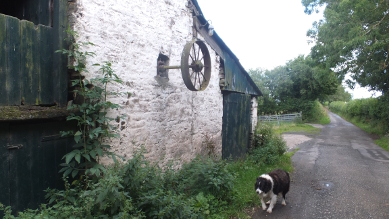
The lane joins one that leads east to The Rhôs. I continue south. The sun is shining and it is warm. However the temperature soon drops when large clouds hide the sun. Mynydd Troed now looms large to the south-west. A furry caterpillar, probably that of a Fox Moth, crawls across the road. The lane enters the hamlet of Genffordd. At the farm I am greeted by an old limping collie. Up the lane a little way another comes for a petting, bringing the first one hurrying up jealously for more attention. A pulley wheel on a shaft emerges from a barn wall. On past a number of barn  conversions. The lane meets the main Abergavenny road at Pengenffordd. The Moriah Chapel of 1835 has a full graveyard. The chapel of Calvinist Methodists, later Presbyterian was rebuilt in 1860 but closed recently and is up for sale for £40,000 although new owners will have to maintain the graveyard, allow access to it and allow future burials. Not surprisingly, it seems to be unsold. Many graves are of local farmers. A little wall post box of Edward VII is in the wall of what looks like an abandoned cottage. A path behind a hedge runs alongside the road to a junction. A lane is the route of the Three Rivers Ride. A short way back, I assisted a German couple who were seeking a riding school. Both of us had difficulty with a weak WiFi signal. Now here there is a mast, maybe half a mile away but it belongs to a different company and my signal is still poor. Apparently, this is how competition benefits the public! A footpath crosses fields. I had hoped to avoid a field of cows being guarded by a large bull but barbed wire forces me back down the hill, into the bulls’ field where I head up the hill quietly without looking at the great beast. A beady eye watches me but the bull does not get up. A Red Kite and Ravens soar high
conversions. The lane meets the main Abergavenny road at Pengenffordd. The Moriah Chapel of 1835 has a full graveyard. The chapel of Calvinist Methodists, later Presbyterian was rebuilt in 1860 but closed recently and is up for sale for £40,000 although new owners will have to maintain the graveyard, allow access to it and allow future burials. Not surprisingly, it seems to be unsold. Many graves are of local farmers. A little wall post box of Edward VII is in the wall of what looks like an abandoned cottage. A path behind a hedge runs alongside the road to a junction. A lane is the route of the Three Rivers Ride. A short way back, I assisted a German couple who were seeking a riding school. Both of us had difficulty with a weak WiFi signal. Now here there is a mast, maybe half a mile away but it belongs to a different company and my signal is still poor. Apparently, this is how competition benefits the public! A footpath crosses fields. I had hoped to avoid a field of cows being guarded by a large bull but barbed wire forces me back down the hill, into the bulls’ field where I head up the hill quietly without looking at the great beast. A beady eye watches me but the bull does not get up. A Red Kite and Ravens soar high  above. Over a stile across the footings of an old wall out of which grow several ancient Ash trees, one of which has holes right through the trunk and numerous stumps from broken limbs. A plane tows a glider over the hill.
above. Over a stile across the footings of an old wall out of which grow several ancient Ash trees, one of which has holes right through the trunk and numerous stumps from broken limbs. A plane tows a glider over the hill.
The path climbs steeply to the summit where there are lumps and bumps of the remains of Castell Dinas. Below the Abergavenny road runs through the Rhiangoll pass making this hill an important defence blocking passage between south and mid Wales. To the east an undulating ridge climbs up into the Black Mountains. To the west is the great whale back of Mynydd Troed. On the north side is a small section of a building. The very top is a circular mound with rubble in the dip in the centre. This mound is formed by the rubble from a keep hall estimated as about 22 by 14 metres. Beneath the keep mound to the east is a well, now just a rubble and nettle filled depression. The layout of the castle is still fairly clear, a keep with a small bailey to the north. A ring wall with a deep ditch beneath it. Two towers are to the north with a gate. The fortress seems to have been constructed in stone from the first possibly by William Fitz Osbern or his son Roger de  Breteuil, Earl of Hereford in the period 1070 to 1075. The castle was eclipsed with the building of Brecon castle before April 1093. Historically the castle remained a part of Brycheiniog barony until 1207 when King John granted it to Peter fitz Herbert. It then became caput of what was to become the Talgarth or Blaenllyfni barony. The castle was sacked by Prince Llywelyn ab Iorwerth in October 1233 and subsequently refortified by King Henry III of England before being returned to Peter fitz Herbert. The castle was again captured by Llywelyn’s grandson, Prince Llywelyn ap Gruffudd in the period 1263 to 1268. The castle was finally destroyed by Owain Glyndŵr’s forces in the early 15th century rebellion. Out of the North gate. There are further lines of defence down the hillside. However, these are much older, the remains of an Iron Age hill-fort on which the castle was constructed. The hill-fort was multivallate and the entrance was through what became the Norman north gate. Down the hill is another herd of cows with their bull. Oh well, easy does it.
Breteuil, Earl of Hereford in the period 1070 to 1075. The castle was eclipsed with the building of Brecon castle before April 1093. Historically the castle remained a part of Brycheiniog barony until 1207 when King John granted it to Peter fitz Herbert. It then became caput of what was to become the Talgarth or Blaenllyfni barony. The castle was sacked by Prince Llywelyn ab Iorwerth in October 1233 and subsequently refortified by King Henry III of England before being returned to Peter fitz Herbert. The castle was again captured by Llywelyn’s grandson, Prince Llywelyn ap Gruffudd in the period 1263 to 1268. The castle was finally destroyed by Owain Glyndŵr’s forces in the early 15th century rebellion. Out of the North gate. There are further lines of defence down the hillside. However, these are much older, the remains of an Iron Age hill-fort on which the castle was constructed. The hill-fort was multivallate and the entrance was through what became the Norman north gate. Down the hill is another herd of cows with their bull. Oh well, easy does it.
The Three Rivers Ride continues up a deeply rutted track is bright red mud. To the west the weather looks bad. A cock Pheasant is calling loudly. I struggle into my wet gear with near perfect timing as the rain arrives. The track, a restricted byway, comes to a metalled lane. Off towards The Rhôs. Past a ruined farm, Blaenau Isaf. A stream flows out of the woods. The rain stops. The pink of Great Willowherb brightens the roadside. Purple-pink Wild Angelica rises out of a ditch. Past The Rhôs, a farmhouse of the late 17th or early 18th century built by a High Sheriff of Breconshire. It has two storeys, a hall with lateral stack and service room at the western end. Later lean-to extensions were added to the gable end and on the north side, and a parlour at the upper end, to which is added a two storey single bay wing with a gable stack. A Congregational chapel is being converted into a dwelling. A lane leads off to the Black Mountains Gliding Club. Here the Three Rivers Ride takes a bridleway north-east. At first the track is very wet and muddy, then it starts to descend and the bedrock is exposed with broken slabs scattered about. The track joins a lane at Heol Rowland, a fine old white farmhouse. The lane drops steeply to a bridge over the Afon Ennig. The bridge dates from the late 1960s or early 1970s as there was a ford here until then. Here the lane enters Hospital Lane.
Past Primrose Hill Cottage. The river is channelled through several weirs. The road is passing through Pwll-y-Wrach, the Pool of the Witch. Past Arosfa which looks like a modern building or at least a modern reconstruction as there was a house in the same place in the mid 19th century. A stream, which rises on Rhiw Cwnstab, comes out of the hill to join the river which drops down one of the many waterfalls along this stretch, although this one is very small. There is a small brick building practically in the stream above the road. Off the road and down into Cwm Pwll-y-Wrach. Only the rushing water can be heard in the valley. Not a single bird is in sight. Down the red slippery mud paths to the waterfalls, then back up to join Hospital Road.
On down the road. A row of houses and The Lodge stand by the gate pillars of the former Mid Wales Hospital. The Mid Wales Hospital, originally the Brecon and Radnor Joint Counties Lunatic Asylum was a psychiatric hospital. The building was designed by Messrs Giles, Gough and Trollope of London and built at a cost of £126,000. It was opened on 18th March 1903, by Lord Glanusk. It was run down in the 1990s and the last wards closed in 1999. Since then permission to demolish has been refused and the building is rotting away with frequent reports of vandalism. Large signs state there is an industrial estate there but no entry is permitted. Down the road and backbone over the bridge where the Afon Ennig enters Talgarth. A small fish dashes across the river to the shelter of an overhanging tree. A ginnell runs down by a house and a little bridge crosses the river just after it falls down a little defile. A path rises up the hill beyond. After a false start I find the path which runs around a pasture. The wind is getting strong, the remnants is Hurricane Gert are on their way but this is probably too soon for this wind to be part of them. The path reaches a lane by a bridge over the River Ellywe running down from Cwm Rhyd-Ellywe. It is now raining steadily. Up the hill is Church Row and a gate into the churchyard. The church is open!
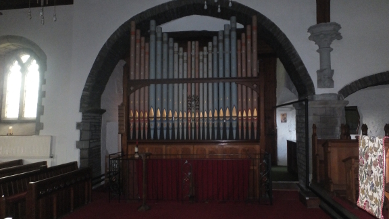
The church of St Gwendoline is late 14th century, built on a Celtic site said to be the burial place of Gwendoline, Gwen frewi, possibly the 11th daughter or possibly the granddaughter of King Brychan Brycheiniog from the 5th century CE. In the 1090s the church at Talgarth was granted to Brecon Priory by Bernard de Neufmarche. The tower is 15th century. The church was extensively restored at cost of £2000 in 1873 by Thomas Nicholson. The tower was renovated in 1898. The north transept was used as a school until 1893, when it was much rebuilt and now contains the organ chamber chamber and vestry. The organ was bought from Worcester in 1883 and decorated by Bertie Diveri. Six bells by Rudhall were hung in 1724. In the tower vestry, unfortunately not open to the public, is a stone with the inscription, “William Vaughan, who was murdered in Abergavenny, son of Sir Roger Vaughan of Porthamel, 1631”. Howell Harris (1714-1773) is buried near the altar. He was inspired to take up preaching by the sermons of Pryce Davies, vicar of Talgarth, in 1735. He became a guiding force in the evolution of Methodism in Wales, and is considered by some to be the most influential Welshman of his time. In 1752 he founded a Methodist community at Trefeca, near Talgarth, which later became a training college for preachers. His burial in an Anglican church is because Methodists generally did not have their own burial grounds. His father, also called Howell, is buried in the churchyard. His son Joseph Harris (1703 – 1764) was a blacksmith, astronomer, navigator, economist, natural philosopher, government adviser and King’s Assay Master at the Royal Mint. A plaque to him and his brother Thomas is on the church wall.
It has stopped raining and the sun blazes down as I head down to the town centre. Route
Sunday – Leominster – Off to the market. The water level in the River Lugg has risen marginally but it is still low and has been so for many months. A Lesser Black-backed Gull is harassing a Grey Heron. The market is fairly busy. A flock of Long-tailed and Blue Tits dash to and fro across Mill Lane. Round to Pinsley Mead. There are a couple of fruit trees there and one has a good crop of plums. All the reachable ones have gone but many remain high up. Giving the tree a good shake brings down nearly five pounds of fruit.
Home – Despite my thinning the apples on the Herefordshire Russet, the crop is still heavy – too heavy in fact and yesterday’s wind has broken two main branches. I will leave them for now but will have to clean it up in the autumn. Marrow-sized courgettes keep appearing as if by magic. There are several decent sized ripe figs on the tree, although it is tricky harvesting them from the top of a precariously positioned set of step-ladders. Our plums seem to have been almost ripe for ages now, but I must be patient. A tray of Cavolo Nero seedlings have got very leggy. I prick some out into individual cells, they may grow on alright.
Monday – Newnham Bridge-Knighton-on-Teme – Newnham Bridge is a small hamlet much increased in size by recent development. The Great Western Railway, Tenbury and Bewdley Branch, completed in 1864 and closed for passengers in 1962, passed through the settlement. A large pub, The Talbot, stands a little further along the road in the junction of the Worcester and Kidderminster road. A lane heads for Bickley and Knighton-on-Teme. At the foot of the lane is a house of 1805 on one corner and the old Post Office, late Victorian, on the other. It is a grey morning. A little way up the lane is the old Smithy, now an extended cottage. The lane crosses the disused railway. Houses have been built across the former track on one side of the bridge. The station still exists as a dwelling. The lane rises and bends past a new housing development under construction. To the east the land falls to the River Rea, a tributary of the Teme. The lane keeps rising. A Victorian house has a large hall attached, the former school which closed in 1983. Jackdaws call. Roadside Damson trees are heavy with fruit. The lane levels. Views are obscured by mist. Common Buzzards are mewing, one flies out of a hedgerow. House Martins and Swallows are feeding across the fields. The Field House is a substantial red brick farmhouse with banding in cream and black bricks. Many field are set to cereals, some already harvested, some awaiting the combine.
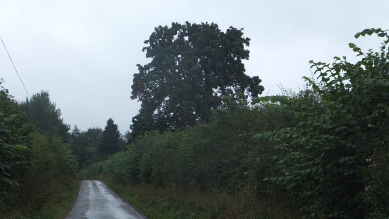
The lane comes to a junction at Bickley, a small hamlet of cottages and orchards. One cottage, the old smithy, has similar brick decoration as Field Farm, almost certainly the same age and same builder. The nearby cottage is called “Brickfield”. It starts to rain. A field contains half a dozen rams. A badly eroded sign is warning “locomotive drivers” that something is “insufficient...beyond the ordinary”, but all else is rusted away. The lane passes between Bickley Pools. A flight of Mallard land on one of the pools which is well stocked with waterlilies. A large pile of logs are well populated by Rusty Gilled Polypore, Gloeophyllum sepiarium fungi. A large house, Sugar Hill, stands back from the lane. A notice declares the verge a nature reserve. One of the largest pear trees I have ever seen stands behind the hedgerow. A Giant Puffball is in the grass on the verge. The lane turns past Corner Cottage, a black and 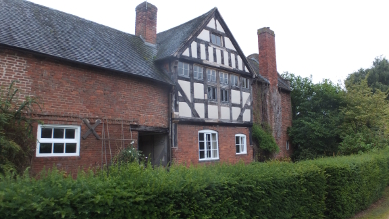 white, then past another, built around 1600 and restored in the last century. A pair of estate workers houses are dated 1965. Guinea Fowl are in a field signed “Beware of the Bull”. More fowl are in the field opposite. Bickley House is another very large red brick farmhouse from the mid 18th century with later additions. Back at Corner Cottage, a driveway passes through rustic wooden gates and manicured lawns to the Great House. This is a former farmhouse originating around 1600. It was remodelled in 1709, although part of the original timber-framed hall is seen on the north side. Attached to the north-east is a large mid 18th century cider house. To the north is a fine threshing barn in brick.
white, then past another, built around 1600 and restored in the last century. A pair of estate workers houses are dated 1965. Guinea Fowl are in a field signed “Beware of the Bull”. More fowl are in the field opposite. Bickley House is another very large red brick farmhouse from the mid 18th century with later additions. Back at Corner Cottage, a driveway passes through rustic wooden gates and manicured lawns to the Great House. This is a former farmhouse originating around 1600. It was remodelled in 1709, although part of the original timber-framed hall is seen on the north side. Attached to the north-east is a large mid 18th century cider house. To the north is a fine threshing barn in brick.
Back near the rams’ field, a female Sparrowhawk clatters out of the hedgerow and off across the fields. On through Bickley Corner. Ivy Dene has a lovely garden with enormous sunflowers. Past Commonwood Villa, which has barns no longer in use. The hamlet of Woodgates Green lies to the north of the lane, but has spread down the lane with 20th century developments. High Hall is well named as it is a rather tall house. The Bank is a sprawling house in brick painted to look like a black-and-white. Seven foot high Cardoons are turning brown in the garden, which is badly overgrown. Maes Court has ornate cast iron gates. The timber-framed house, previously known as The Jewkes, is partly hidden by a vast Copper Beech. It was built as a house and barn around 1630 and modified into a single building in the mid 20th century. Past Knighton-on-Teme Parish Room. The rain returns. A large old Rectory stands next to the Parish Room. The lane is gated with fine wrought iron gates which have probably not been closed for some time. Church Farm is large with a fine Georgian farmhouse of the mid 18th century. The church of St Michael and All Angels stands nearby.
The farm and church lay in a valley surrounded by an abandoned mediaeval village. After the Romans departed the Western Hecani, a pagan West Saxon tribe, ruled the area. They converted to Christianity around 660, probably by the same Celtic Northumbrian missionaries that founded Leominster Priory. The Hwicci tribe infiltrated from the east and annexed the Knighton-on-Teme area for Worcester when the boundaries were set by King Edward the Elder. It is said that Wiferd, leader of the Hwicci granted land here to the Prior of Worcester Convent around 790. However,  there is no record of Wiferd until the 10th century so it is likely the gift was made by Duke Uhtred in 757. These lands were lost to the Priory, in all likelihood when the Danes defeated the Mercians in 874. The lands were restored to Bishop Wulstan by William I between the Conquest and Domesday. Between 1100 and 1135 the lands were confirmed the lands of Lindridge to the Priory and the present church was built as Chapelry in the parish of Lindridge. For many years the inhabitants of Knighton-on-Teme requested they become independent of Lindridge. The lands, as Lindridge Manor were confiscated during the Commonwealth and sold to George Cony of London but restored after the Restoration.
there is no record of Wiferd until the 10th century so it is likely the gift was made by Duke Uhtred in 757. These lands were lost to the Priory, in all likelihood when the Danes defeated the Mercians in 874. The lands were restored to Bishop Wulstan by William I between the Conquest and Domesday. Between 1100 and 1135 the lands were confirmed the lands of Lindridge to the Priory and the present church was built as Chapelry in the parish of Lindridge. For many years the inhabitants of Knighton-on-Teme requested they become independent of Lindridge. The lands, as Lindridge Manor were confiscated during the Commonwealth and sold to George Cony of London but restored after the Restoration.
The church is entered through a south door. It is a narrow door typical of Romanesque work from around 1137. Above the door is an arcade of four arches. Inside, the chancel arch has a band of star-work around it. The arch is flanked each side by a blind arcade of two arches. The nave roof is of the 15th century, with moulded tie-beams. The chancel was rebuilt in the 14th century and again in 1910. There are memorials in the floor mainly to the Milward family. The east window is in memory of Revd Wroth who died in 1896. The east jamb of 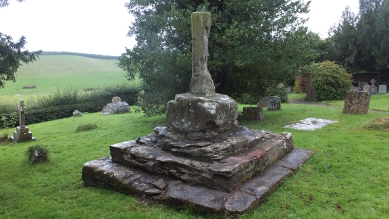 north-east nave window has small late 17th century memorial surmounted by a large coat of arms to John Cecil, High Sheriff of Bristol, who died in 1697. The “devil’s door” in the north wall has been blocked up and the War Memorial set in it. Below is a mediaeval chest. The original communion table has 17th century baluster legs and now stands by the door. The current table is modern. Like most churches, there is evidence of extensive wall paintings. The Bell Turret has four massive upright oak beams dated to 1137. There were formerly three bells: the first cast by John Martin, 1661, the second mediaeval, dedicated in honour of St Michael, and the third dated 1625. At present only two exist, a bell originally of 1625 recast by James Barwell of Birmingham in 1885, and a small “ting-tang” without inscription. The turret was rebuilt in 1959 but came under attack by Green Woodpeckers! It had to be rebuilt again in recent years. The church has plate, of course not held here, consisting of a silver cup and cover paten of the Elizabethan period, which have no plate-marks, but the paten bears the date 1577, and a chalice, paten and flagon of 1865. In the graveyard is an ancient and very eroded cross, thought to be from the 13th century. There is also a large Yew tree nearby.
north-east nave window has small late 17th century memorial surmounted by a large coat of arms to John Cecil, High Sheriff of Bristol, who died in 1697. The “devil’s door” in the north wall has been blocked up and the War Memorial set in it. Below is a mediaeval chest. The original communion table has 17th century baluster legs and now stands by the door. The current table is modern. Like most churches, there is evidence of extensive wall paintings. The Bell Turret has four massive upright oak beams dated to 1137. There were formerly three bells: the first cast by John Martin, 1661, the second mediaeval, dedicated in honour of St Michael, and the third dated 1625. At present only two exist, a bell originally of 1625 recast by James Barwell of Birmingham in 1885, and a small “ting-tang” without inscription. The turret was rebuilt in 1959 but came under attack by Green Woodpeckers! It had to be rebuilt again in recent years. The church has plate, of course not held here, consisting of a silver cup and cover paten of the Elizabethan period, which have no plate-marks, but the paten bears the date 1577, and a chalice, paten and flagon of 1865. In the graveyard is an ancient and very eroded cross, thought to be from the 13th century. There is also a large Yew tree nearby.
Through the second set of gates. The lane starts to rise. A Chiffchaff wheeps in a Hawthorn. The lane rejoins the lane up from Newnham Bridge near the school. Over 60 Jackdaws sit on power lines. I liberate some of the damsons from the trees I passed earlier. Back down to the village. Route
Friday – Hollybush-Berrow – I park at All Saints Church, Hollybush. This is in the A438, which passes over the Malvern Hills. Raggedstone Hill towers to the west, a grass summit emerging from a dense wood where there is just a tinge of autumn. The story is told how a monk from the Benedictine Priory at Little Malvern fell in love with a local girl and proceeded to break his vows of chastity. His Prior prescribed the punishment: every day he had to crawl up to the top of Raggedstone Hill on his hands and knees and say a prayer of penance. Eventually he got to the end of his tether and after dragging himself up to the 750 feet summit, he placed a curse on the hill, “May all upon whom the shadow of this stone falls untimely die”, he proclaimed. Whereupon, he dropped dead. On the other side of the road through the hills is Midsummer Hill.
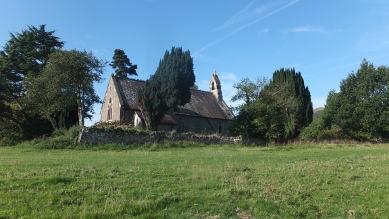
Hollybush is a scattered community. In 1869, the Worcester Journal commented, “... as the Hollybush is the boundary where meet the three dioceses of Worcester, Hereford, Gloucester and Bristol, there could hardly be said to be any episcopal supervision; spiritual life at such geographical extremities was scarcely manifested at all; it was a sort of “no man’s” land, save one large and two small farms, and the poor cottagers were as sheep having no shepherd. Can it be a source of wonder, then, that a district lying so open to attack by the powers of evil should have been selected a few years ago by the Mormons, who made a raid upon it and carried off thirty families to the Salt Lake!”
It is still relatively early so it is not surprising the church is not yet open. A Chiffchaff is calling. Round to the back of the church. Here a Robin is in good voice. Paths lead past cottages in Golden Valley, across an area of linked commons, Coombe Green and Hollybush Commons, which along with Castlemorton Common are the remains of Malvern Chase. Great banks of brambles covered in red and black blackberries, rise out of the bracken. Behind them are Blackthorn, Hazel, Willow and Hawthorn, draped with Old Man’s Beard. The sun is hot with just a scattering is cirrus clouds. To the north the land rises to the long ridge of the Malvern Hills. The path descends then runs alongside a stream which feeds a large millpond which has a small wooded island. Domestic geese feed in a field on the opposite side of the pond. Flesh flies in their grey pin striped suits sun themselves on a notice. A large house overlooks the pond the far side. A metalled road leads away from the pond southwards. Houses line the road, although not densely. Most are late 19th or 20th century.
The lane joins a larger road. Mill Farm farmhouse is a large, probably 18th century building. Masons Farm has peacocks for sale! The leaves of roadside trees are turning yellow, gold and red. On the junction to Castlemorton is Bannut Tree House. From the road it is timber-framed building with 1576 carved on an upper beam. However, attached is an Arts and Crafts house by Voysey, his first medium to large commission, built in 1890. The parish hall stands on the opposite corner. Towards the village. The old Post Office is a residence but retains its post box. Opposite a public footpath sign points to a bramble and nettle patch. The old Almshouse has a 14th or 15th century hall core but was “restored” in 1962 by Reginald Craft. Frisby House has cruck remnants within, with a wing added in 1901 and half-timbered, thatched and changed to an H-plan in 1924. Opposite are stables and a drying out pond. Rough Chase, 17th century farmhouse with a 16th or 17th century wing. The large houses are followed by a row of 20th century homes.
The church of St Gregory, after Gregory the Great 540-604. The old name of the village was Morton-Folliott. The church is 12th century with a tower from 1387, added to in the 17th century and restored in 1879 and 1897. The church may stand on the site of a Saxon church. The chancel arch is probably 14th century. The arcade is Norman with three pillars replaced in 1387. The font is 17th century. The altar and reredos are by Richard Haughton and added in 1900. The east window is of the same date and is by Hardman. A gallery for musicians was built in 1724 but removed in 1879. The organ is by Nicholson, installed in 1885. Windows and niches in the nave are thought to have come from the runs of Little Malvern Priory and inserted in 1683. There are six bells; all rehung in 1896 when the tenor and two others were recast by Llewellins and James of Bristol. The three old bells are two by Abraham Rudhall of Gloucester dated 1695 and one recast by John Rudhall in 1795. In the churchyard, a wooden cross held in an iron bracket on a stone base is believed to be 14th century.
Opposite is the old Vicarage, probably from 1800. Next to the church is Folliott House, a farmhouse dated 1785. A lane heads south past the old School House. The modern school is just a little  further on. Opposite is Castlemorton Tump, a motte and bailey of an earth and timber castle built by the Folliott family around 1140. The castle was bought by Richard de Berkyng, Archbishop of Westminster, in the first half of the 13th century. To the north west are the earthworks of the mediaeval village. Beside a path off the road is a Crab Apple tree loaded with oval, orange-red little apples. Past two sets of semi detached houses probably built for farm workers of Bray’s Farm. A pristine Red Admiral is on Hazel leaves. A Hampshire Fire Brigade engine from the Sutton Scotney station is in a field by the Farmers Arms, a 17th century pub. Round a bend and into Birts Street. A long village of cottages, farms and modern infill. Providence Cottage is constructed of two railway carriages, parallel to each other and joined. It dates from the early 20th century. The Wesleyan Chapel, built 1844, closed in the late 1980s and is now a residence and next door, the Wesleyan Chapel Hall beside it is also now a home.
further on. Opposite is Castlemorton Tump, a motte and bailey of an earth and timber castle built by the Folliott family around 1140. The castle was bought by Richard de Berkyng, Archbishop of Westminster, in the first half of the 13th century. To the north west are the earthworks of the mediaeval village. Beside a path off the road is a Crab Apple tree loaded with oval, orange-red little apples. Past two sets of semi detached houses probably built for farm workers of Bray’s Farm. A pristine Red Admiral is on Hazel leaves. A Hampshire Fire Brigade engine from the Sutton Scotney station is in a field by the Farmers Arms, a 17th century pub. Round a bend and into Birts Street. A long village of cottages, farms and modern infill. Providence Cottage is constructed of two railway carriages, parallel to each other and joined. It dates from the early 20th century. The Wesleyan Chapel, built 1844, closed in the late 1980s and is now a residence and next door, the Wesleyan Chapel Hall beside it is also now a home.
Back through the village to a lane that runs the other side of the Farmers Arms. Past Pink Hall, a large thatched house. Opposite is Pope Hayes, a mid 17th century timber-framed house with a large attached barn. The road reaches a junction at Little Arley. There are a number of “stag-horn” Oaks in the fields, ancient trees whose top branches have died leaving thin spikes in the air like stag’s horns. The house, Little Arley, looks relatively modern. A lane leads to Birtmorton Court and the church of St Thomas of Canterbury with St Peter and St Paul, which is locked. The church is 14th century, restored in 1877. The court is viewable only by appointment. It is the birthplace of prominent statesman William Huskisson.
In public life, Huskisson caught the eye of William Pitt the Younger, the Prime Minister, and became Under Secretary at War; but when he was 29 and on his honeymoon, he had a brush with death when he contrived to fall underneath a horse. Worryingly, Huskisson was also flattened by the pole of a carriage at the entrance to Horse Guards and tried to leap a moat in Scotland but missed. This resulted in him walking with an unusual gait. He rose to the offices of President of the Board of Trade and Secretary of State for War and was invited in September 1830 to the opening ceremony of the first double-track railway line, from Manchester to Liverpool. Now MP for Liverpool, he had fallen out with the Duke of Wellington a couple of years earlier and resigned from the cabinet. Hoping for some kind of reconciliation, he went up to the Duke’s railway carriage when water was being taken on board and proffered a hand to him. Unfortunately, in his eagerness, he failed to see Stephenson’s Rocket coming up the opposite track. Already hampered by inflammation of the bladder and kidneys from exposure at George IV’s funeral in July, he struggled to get out of the way, panicked and tried to clamber into the Duke’s carriage, but the door of the carriage swung open leaving him hanging right in the path of the oncoming steam engine. He fell onto the tracks and his leg was horrifically mangled under the wheels. The hapless William Huskisson died about nine hours later and he became the first fatal railway casualty to be widely reported.
A short way down the lane, Birtsmorton Court can be glimpsed. It is a 16th century moated house on 14th century remains. In 1424-25 Birtsmorton became the seat of John Nanfan, who had most of the earlier structure demolished before his death in about 1447. The house was remodelled for Giles Nanfan in about 1572. Birtsmorton was the birthplace of the chairmaker Philip Clissett who lived in the parish from his birth in 1817 until about 1842. On down the lane and across the A438 and then into Chadds Lane. The lane turns into Church Lane which leads shortly into Berrow. A large rambling white house is The Vicarage. Attached is the School of St Faith, built in 1903. Through gates installed in 1953 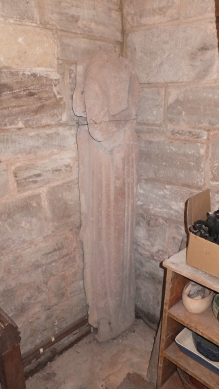 for the Coronation and to St Faith’s church.
for the Coronation and to St Faith’s church.
St Faith’s is a 14th century church on an earlier site. The tower is 15th century. The church warden tells me about the church, which has recently been restored, and shows me a mysterious stone effigy standing in the corner of the tower. Hardly anything is known about the effigy. It appears to be that of a woman although the head is missing and is probably 13th century. It may well have been on a tomb which was attacked during the Reformation. The font is Norman. The pulpit is 17th century. It is a simple church and none the worse for that. The glass is Victorian. There is a ring of five bells by Gillett and Johnson. By the porch is a memorial plaque to Edward Gummary, his wife Elizabeth and daughter Anne who were murdered on 7th May 1780, a crime that was never solved. Outside, the warden tells me a 13th century grave slab was unearthed during groundworks. It has a cross carved on it and is in such good condition that it is suspected that it was once inside the church. It has been reburied to protect it. The preaching cross has a large worn head and is of uncertain date.
The warden has told me that Pendock church is closed because of a robbery, so I decide to head back in the direction of Hollybush. Out of Church Lane and into Whiting Hill Lane. Past the end is Whiting Lane which leads to Whiting-Ash Farm. The lane enters the Gloucester Road. At Camers Green, I turn along Black Lane. Common Fleabane flowers on the verge. Black Lane comes to a junction and Chase End Street heads up to Hollybush. Hawthorns, an early 19th century large Georgian three storied house stands by the junction. Wood Pigeons are everywhere,  clapping their wings and cooing. A large farm Gate House, has a moat at the south end of the buildings. The farmhouse dates from 1600. Jackdaws are circling on an updraught. An old timber framed barn, only some twenty feet long stands by the road in front of Perrin’s Court. Both are 17th century. At Gray’s Cottage, once two 17th century houses, a lane, White-leaved Oak leads off but I stay on Chase End Lane. A Southern or Blue Hawker dragonfly, Aeshna cyanea, darts to and fro. A Violet Ground Beetle sets out across the tarmac but changes is mind and does a U-turn back into the grassy verge. A small black spider is braver and makes the whole way across. Up to The Lodge, a thatched cottage at Glenbarrow. Off across the fields. I step off the path to allow someone to pass and almost fall over a large ant hill. There are dozens of them along the path. A Parasol Mushroom is rotting. A footbridge crosses a still, muddy stream then the path crosses a meadow to the top of Combe Green Common.
clapping their wings and cooing. A large farm Gate House, has a moat at the south end of the buildings. The farmhouse dates from 1600. Jackdaws are circling on an updraught. An old timber framed barn, only some twenty feet long stands by the road in front of Perrin’s Court. Both are 17th century. At Gray’s Cottage, once two 17th century houses, a lane, White-leaved Oak leads off but I stay on Chase End Lane. A Southern or Blue Hawker dragonfly, Aeshna cyanea, darts to and fro. A Violet Ground Beetle sets out across the tarmac but changes is mind and does a U-turn back into the grassy verge. A small black spider is braver and makes the whole way across. Up to The Lodge, a thatched cottage at Glenbarrow. Off across the fields. I step off the path to allow someone to pass and almost fall over a large ant hill. There are dozens of them along the path. A Parasol Mushroom is rotting. A footbridge crosses a still, muddy stream then the path crosses a meadow to the top of Combe Green Common.
The church of All Saints is now open. It is a small church built of local stone with limestone dressings. It was built for the local miners in 1869, extended in 1929, as a chapel of ease to Castlemorton. The architect was Frederick Preedy who also designed the stained glass of the east window. It became a separate parish in 1913. There is some lovely modern glass by Rowan Mconegal. Route
Tuesday – Bodenham Lake – Drizzle turns to fine rain. Fifteen Cormorants take to the air as I approach the sailing bay. The meadow has been mown. Along to the hide. There is a scattering of wildfowl on the lake – Mallard, Tufted Duck, Gadwall, Coot and the Mute Swan family with five cygnets. A Great Crested Grebe preens. A Sand Martin sweeps low across the water. A Common Sandpiper stalks the edge of the scrape. The rain has highlighted the numerous spider’s webs strung across the dead heads of Black Knapweed. A willow in the reed bed is suddenly alive with birds – a Reed Warbler, Blackcap, Blue Tit and two Blackbirds. There are more warblers around the reed bed, Chiffchaffs I think, then one calls confirming this. A Moorhen has a vigorous wash in the water beside the scrape. The young Bullfinches now are in the willow. A Moorhen chick appears from the reeds. I realise there is not a single Canada Goose around. Now a Dunnock arrives in the reeds. Now three Reed Warblers appear, youngsters I think. A Robin is singing short bursts of song in a Willow on the other side of the scrape. The rain is a fine mist now but it is getting darker. A young Song Thrush arrives in the willow and looks around as if it is not sure what to do next. A wasp is chewing at the woods of the hide window. Purple Loosestrife is still in flower on the scrape. I collect some blackberries as I return to the orchards.
Wednesday – Erwood-Crickadam-Gwenddwr – I park in the centre of the village of Erwood which stands on the A470 in the Wye valley between Builth Wells and Three Cocks. The Cletwr Brook runs through a deep channel under the road. Overnight rain has recently ceased. The wooded hills have drifting clouds over them. Beside Erwood Bridge, widened in 1937, is a community run public convenience. Over the road is the village pump with a niche containing a statue of a maid erected for the millennium. The houses are stone built and mainly painted. The village stores, despite a wooden sign, has closed and is now a residence. The large Erwood Hall is for sale. The hall is an early 19th century smaller gentry house which is marked on the Crickadarn Tithe map of 1842 as a holding of 58 acres owned and occupied by David Evans. Up a lane which climbs into the hills. A small crescent looks out over the valley below through which the Wye flows. Modern houses are either side of lane as it leaves the village. The Hepzibah Baptist Chapel lies on the hillside with a graveyard of some large monuments. It was built in 1827 and reconfigured some years later, moving a door from the long side to the gable end. A stone stands out from the wall, probably the end of a beam. It is eroded but part of an inscription remains, “H. & J.H.G Velin Vach”. Peering through the window reveals a large pulpit in the centre of the south wall facing the pews, with a harmonium beside it. The road levels out. To the north is a precipitously steep wooded valley with Cletwr Brook running through it, not visible but audible. Robins sing and Nuthatches call. The land still rises to the south forming a ridge, an outcrop of Raglan Formation mudstone. A large farm, Llawrllan, has an impressive 18th century farmhouse and some barns converted into accommodation.
The lane enters Crickadarn. A flock of House Sparrows chase through the hedges. The road comes to a junction. A large chapel, the Hebron Congregational stands on one corner. It was built in 1854 and renovated in 1901. It was one of the chapels which were built by the early Independent preachers in the area. Independent chapel said to have been one of the earliest Independent causes in the region, preaching having begun in the valley in the 17th century from the chapel at Llanigon, and the first chapel built around 1690-1700. Early preachers included Henry Maurice, “the apostle of Breconshire” and Rees Prytherch. The Independents declined then revived in the 19th century when the Crickadarn chapel was built. The graveyard again has some substantial monuments and is still in use. Blackbirds fuss along the base of the hedge. Opposite is a large house with a cottage attached, all in painted stone. The house was formerly a pair of 19th century cottages, which were joined in the 20th century. One of the cottages marked on the Crickadarn Tithe map of 1842 as owned and occupied by Thomas Morgans. Opposite is another large house, Firtree, a mid 19th century former inn on an important drovers’ road across mid-Wales. It is marked on the Crickadarn Tithe map of 1842 as Fir Tree Inn owned by Roger Powell and occupied by John Miles. Across the junction is the church of St Mary.
The church is locked, however I locate the key in a ledge in the porch. The key is a wonderful old type of considerable size. There is a very worn stoup in the porch, which is of some  considerable age. The tower is an impressively large and solid build. A mouse runs runs towards the porch then realised I am there and retreats rapidly. The church is plain with plastered walls and ceiling. The building is 14th century, the tower 15th or early 16th century. However, the church is on a raised mound which suggests an earlier building. Restoration was carried out by Sir Clough Williams-Ellis in 1867 and 1895, but more extensive work was required in 1906. A door and small balcony dating from 1906 are high on the tower wall. The walls build a number of plaques from the late 18th and early 19th centuries. A small, ornate harmonium stands behind the pulpit. An octagonal font is 14th century. A large safe is in the wall. There are four bells, treble marked “TI RD CW 1710”; second marked “Thomas Probert John Maddock (Fleur de Lys) CW 1701”; Third marked “Gloriam Deo in Excess (Fleur de Lys) 1701” and a Tenor marked “In Gloriam DEI Sono 1719” and has an ornamental band. Behind the tower is a tomb in a cast iron
considerable age. The tower is an impressively large and solid build. A mouse runs runs towards the porch then realised I am there and retreats rapidly. The church is plain with plastered walls and ceiling. The building is 14th century, the tower 15th or early 16th century. However, the church is on a raised mound which suggests an earlier building. Restoration was carried out by Sir Clough Williams-Ellis in 1867 and 1895, but more extensive work was required in 1906. A door and small balcony dating from 1906 are high on the tower wall. The walls build a number of plaques from the late 18th and early 19th centuries. A small, ornate harmonium stands behind the pulpit. An octagonal font is 14th century. A large safe is in the wall. There are four bells, treble marked “TI RD CW 1710”; second marked “Thomas Probert John Maddock (Fleur de Lys) CW 1701”; Third marked “Gloriam Deo in Excess (Fleur de Lys) 1701” and a Tenor marked “In Gloriam DEI Sono 1719” and has an ornamental band. Behind the tower is a tomb in a cast iron  enclosure. The tomb is slowly being buried by Ivy. Nearby is a footpath in very poor condition. It leads into a muddy sedgy cow field. On the hillside to the north-west is an earthwork, although little can be discerned as bushes and trees obscure much of it. It is about 160 feet across and was surrounded by a ditch 10 feet deep and a bank. There was almost certainly a timber castle here but it is unlikely to have been upgraded to a masonry one. Three Normans held land around the area, Bernard Neufmaché, Ralph Tosny and the Braose family. Any of them could have built this small fortress. In the 12th century, Roger, Earl of Hereford gave land to Walter Clifford who was married to Margaret Tosny. Clifford gave the northern part comprising of Gwenddwr and Llaneglwys to Abbey Dore monastery.
enclosure. The tomb is slowly being buried by Ivy. Nearby is a footpath in very poor condition. It leads into a muddy sedgy cow field. On the hillside to the north-west is an earthwork, although little can be discerned as bushes and trees obscure much of it. It is about 160 feet across and was surrounded by a ditch 10 feet deep and a bank. There was almost certainly a timber castle here but it is unlikely to have been upgraded to a masonry one. Three Normans held land around the area, Bernard Neufmaché, Ralph Tosny and the Braose family. Any of them could have built this small fortress. In the 12th century, Roger, Earl of Hereford gave land to Walter Clifford who was married to Margaret Tosny. Clifford gave the northern part comprising of Gwenddwr and Llaneglwys to Abbey Dore monastery.
Back to the church yard and off along the lane to the north. There is an extension to the graveyard with recent burials. The lane descends into a valley, Cwm Catti, where a stream passes under the lane then drops steeply down into a deep defile to join another stream that pours out of a culvert further along the lane. A water hydrant sign stands in the woodland above the culvert. At a junction, a sign states “Nueadd 1670”, which leads to a house, also known as Pool Hall, of that date. Good numbers of House Martins feed overhead. Past a 20th century house. The lane drops again. A footpath sign points down into the valley but I would not like to try and get down it! However, the old maps show a track here although how it reached the road is now unclear. The track ran down to a corn mill at Craig y Gâth. The mill is shown as disused by 1904. The lane undulates as it runs along the valley side. Water can be heard flowing far below. The woodland clears for a space and Cletwr Brook can be seen flowing over rocks. The lane continues past fields of sheep and a number of farms. Penrhiwgoch is a substantial house that has a 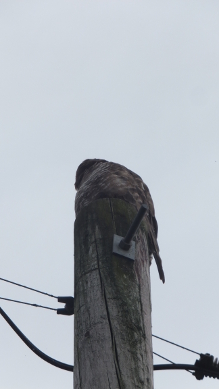 vaguely Arts and Crafts look. The lane descends again. A pair of rotting Parasol Mushrooms stand on the verge. The lane crosses a bridge over the brook at Abergwenddwr. Another stream, Nant Gwenddwr, joins the brook just above the bridge. Further on the lane crosses this stream. The lane climbs steeply yet again. Some flowers bloom on a bit of waste ground. I recognise Red Valerian and one of the Mallows but a third is familiar but I cannot name. A Common Buzzard is atop a telegraph pole and totally oblivious of me as I creep up behind it. It is only when I have passed the bird it realises and flies off.
vaguely Arts and Crafts look. The lane descends again. A pair of rotting Parasol Mushrooms stand on the verge. The lane crosses a bridge over the brook at Abergwenddwr. Another stream, Nant Gwenddwr, joins the brook just above the bridge. Further on the lane crosses this stream. The lane climbs steeply yet again. Some flowers bloom on a bit of waste ground. I recognise Red Valerian and one of the Mallows but a third is familiar but I cannot name. A Common Buzzard is atop a telegraph pole and totally oblivious of me as I creep up behind it. It is only when I have passed the bird it realises and flies off.
Into Gwenddwr. The Bryn Sion Congregational Chapel was erected in 1888. It appears abandoned as the doors are held closed by a piece of string. A short terrace of stone cottages runs up the hill. On down the lane is an old school of 1864 with mid 20th century additions, now all dwellings. The Unicorn still has a faded pub sign on the wall but is now a dwelling. A track up beside the old pub leads to the church of St Dubricius, founded by Cistercian monks of Abbey Dore in the 14th century. The church and land was seized at the Dissolution and sold to Sir David Williams in 1612. The church was in poor condition in the early 19th century when Theophilus Jones visited and commented that the alehouse roof was in better condition than the church’s. In 1876 much of the building was destroyed by fire. It was rebuilt over the next decade at a cost of £890. The mediaeval font survived as did the 15th century porch. There are three bells, two by Evans of Chepstow dating from 1700 and the third by Abraham Rudhall of Gloucester dated 1797.
Whilst in the church it started raining, so I wait till passes. Back to the chapel and up the hill and off down another lane. Past another small graveyard extension. Down another steep hill. Past Tircanvas where the house and barns are all one building. An enormous monolith of sandstone is upright by a gate. It is relatively modern as there is limited wear. The lane drops even more steeply. Chaffinches fly out of the hedgerow. The lane crosses Cletwr Brook again by a narrow hump backed bridge. Then the lane climbs back up into the hills again. Up and up, past Pen-twyn and Cillian-Fawr farms. An old Collie cross looks up as I pass but cannot be bothered, but more collies in cages and a horse box go mad at me. Finally the lane levels out near Blaen-huddig, although the hills peak around me. A Robin is singing and a woodpecker tapping. A Common Buzzard mews overhead. Cefn Llwydallt is moorland and lies to the south of the lane, which is now descending steeply again. Down the valley slightly to my left is the tower of Crickadarn church. A stream flows far below having come from a spring at Blaen-huddig. Past Lower 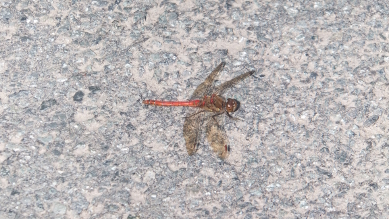 Rheol. A sheep pasture has a large pond and numerous House Sparrows around the feeding troughs. An Elder has large bunches of purple-black berries. The clouds have broken and the sun is shining. A track leads off which would shorten my route but add another steep drop and climb. Pool Hall is a large farm beyond the track. Two Ravens hassle a Common Buzzard overhead. The footpath to the church runs off this lane but that is also an uninviting prospect.
Rheol. A sheep pasture has a large pond and numerous House Sparrows around the feeding troughs. An Elder has large bunches of purple-black berries. The clouds have broken and the sun is shining. A track leads off which would shorten my route but add another steep drop and climb. Pool Hall is a large farm beyond the track. Two Ravens hassle a Common Buzzard overhead. The footpath to the church runs off this lane but that is also an uninviting prospect.
The lane joins the Llaneglys road which then drops down into Crickadarn. A dragonfly, a Common Darter, Sympetrum striolatum warms itself on the tarmac. It has a bright orange-red body. In the village, opposite the chapel is a water spout I had missed on my way past earlier. It has a broken iron knob and a lion’s head spout. Between the knob and spout is the legend “T. Kennedy Patentee Kilmarnock”. Down the road there is a basket of apples outside a bungalow, with a note saying “Help yourself”. As I forgot to pick up any apples this morning before leaving, I grab one. A voice urges me to take more. The woman from the house is sitting in the garden. I explain I have a large crop myself but forgot to bring any today. Back in Erwood I wander up the road a short way. The Diamond Jubilee Market Hall was built in 1898 and is still in use for the community. The Wheelwrights Arms is open but I am driving. Route